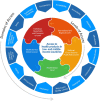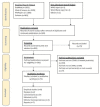Barriers to COVID-19 Health Products in Low-and Middle-Income Countries During the COVID-19 Pandemic: A Rapid Systematic Review and Evidence Synthesis
- PMID: 35937225
- PMCID: PMC9354133
- DOI: 10.3389/fpubh.2022.928065
Barriers to COVID-19 Health Products in Low-and Middle-Income Countries During the COVID-19 Pandemic: A Rapid Systematic Review and Evidence Synthesis
Abstract
Introduction: The coronavirus disease 2019 (COVID-19) pandemic has intensified the urgency in addressing pressing global health access challenges and has also laid bare the pervasive structural and systemic inequities that make certain segments of society more vulnerable to the tragic consequences of the disease. This rapid systematic review analyses the barriers to COVID-19 health products in low-and middle-income countries (LMICs). It does so from the canon of global health equity and access to medicines by proposing an access to health products in low-and middle-income countries framework and typology adapted to underscore the complex interactive and multiplicative nature and effects of barriers to health products and their root cause as they coexist across different levels of society in LMICs.
Methods: Modified versions of the Joanna Briggs Institute (JBI) reviewers' manual for evidence synthesis of systematic reviews and the PRISMA-ScR framework were used to guide the search strategy, identification, and screening of biomedical, social science, and gray literature published in English between 1 January 2020 and 30 April 2021.
Results: The initial search resulted in 5,956 articles, with 72 articles included in this review after screening protocol and inclusion criteria were applied. Thirty one percent of the articles focused on Africa. The review revealed that barriers to COVID-19 health products were commonly caused by market forces (64%), the unavailability (53%), inaccessibility (42%), and unaffordability (35%), of the products, incongruent donors' agenda and funding (33%) and unreliable health and supply systems (28%). They commonly existed at the international and regional (79%), health sectoral (46%), and national cross-sectoral [public policy] (19%) levels. The historical heritage of colonialism in LMICs was a commonly attributed root cause of the barriers to COVID-19 health products in developing countries.
Conclusion: This review has outlined and elaborated on the various barriers to health products that must be comprehensively addressed to mount a successful global, regional, national and subnational response to present and future epidemics and pandemics in LMICs.
Keywords: COVID-19; access to medicines (ATM); global health; low resource settings; low-and middle- income countries; systematic review.
Copyright © 2022 Boro and Stoll.
Conflict of interest statement
The authors declare that the research was conducted in the absence of any commercial or financial relationships that could be construed as a potential conflict of interest.
Figures




Similar articles
-
Beyond the black stump: rapid reviews of health research issues affecting regional, rural and remote Australia.Med J Aust. 2020 Dec;213 Suppl 11:S3-S32.e1. doi: 10.5694/mja2.50881. Med J Aust. 2020. PMID: 33314144
-
Impact of COVID-19 on medical education in different income countries: a scoping review of the literature.Med Educ Online. 2022 Dec;27(1):2040192. doi: 10.1080/10872981.2022.2040192. Med Educ Online. 2022. PMID: 35317712 Free PMC article.
-
Resilience of primary healthcare system across low- and middle-income countries during COVID-19 pandemic: a scoping review.Health Res Policy Syst. 2023 Sep 18;21(1):98. doi: 10.1186/s12961-023-01031-4. Health Res Policy Syst. 2023. PMID: 37723533 Free PMC article.
-
Telemedicine in Low- and Middle-Income Countries During the COVID-19 Pandemic: A Scoping Review.Front Public Health. 2022 Jun 22;10:914423. doi: 10.3389/fpubh.2022.914423. eCollection 2022. Front Public Health. 2022. PMID: 35812479 Free PMC article.
-
Telehealth services for global emergencies: implications for COVID-19: a scoping review based on current evidence.BMC Health Serv Res. 2023 Jun 1;23(1):567. doi: 10.1186/s12913-023-09584-4. BMC Health Serv Res. 2023. PMID: 37264401 Free PMC article.
Cited by
-
COVID-19 in Africa: Supply chain disruptions and the role of the Africa Continental Free Trade Agreement.J Glob Health. 2022 Dec 17;12:03085. doi: 10.7189/jogh.12.03085. J Glob Health. 2022. PMID: 36527268 Free PMC article. No abstract available.
-
Choosing and accessing COVID-19 treatment options: a qualitative study with patients, caregivers, and health care providers in Lebanon.Health Res Policy Syst. 2024 Mar 27;22(1):38. doi: 10.1186/s12961-024-01131-9. Health Res Policy Syst. 2024. PMID: 38539218 Free PMC article.
-
The effect of COVID-19 on the non-COVID health outcomes of crisis-affected peoples: a systematic review.Confl Health. 2024 Apr 25;18(1):37. doi: 10.1186/s13031-024-00592-7. Confl Health. 2024. PMID: 38664834 Free PMC article. Review.
-
Causal effects of education, intelligence, and income on COVID-19: evidence from a Mendelian randomization study.Hum Genomics. 2025 Feb 25;19(1):18. doi: 10.1186/s40246-025-00731-y. Hum Genomics. 2025. PMID: 40001252 Free PMC article.
-
At risk but not adequately included: People with disabilities' experience of COVID-19 in Zambia.Afr J Disabil. 2024 Nov 15;13:1448. doi: 10.4102/ajod.v13i0.1448. eCollection 2024. Afr J Disabil. 2024. PMID: 39650093 Free PMC article.
References
-
- World Health Organization. Listings of WHO's response to COVID-19. (2021). Available online at: https://www.who.int/news/item/29-06-2020-covidtimeline (accessed March 28, 2021).
-
- Roser M, Ritchie H, Ortiz-Ospina E, Hasell J. Coronavirus Pandemic (COVID-19). (2022). Available online at: https://ourworldindata.org/coronavirus-data (accessed June 5, 2022).
Publication types
MeSH terms
LinkOut - more resources
Full Text Sources
Medical
Research Materials
Miscellaneous

